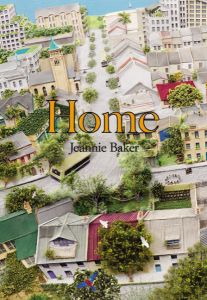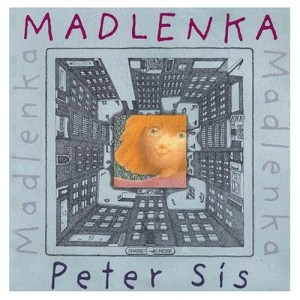
My son (age seven) re-painting the “cheetah” street bollard that he originally helped create out of a tagged and somewhat unloved space when he was three and a half.
This post is a love letter to my five all time favourite kid’s books about cities, neighbourhoods and community.
Well worn and ragged, each has been well tested at my family’s house and and are the kind of picture books that can be enjoyed over and over again by younger citizens and their older fans alike.
Important to me, none of these are preachy or didactic. Instead, each gives a glimpse of cities and communities at their best and lets those enjoying the books draw their own conclusions. (And for those reading this from the Victoria, BC area, all of these can be found at the Greater Victoria Public Library).
Got others you think should be on this list? I’d love to hear about them in the comments below.
#1 – “Home” by Jeannie Baker – Done entirely without words, this book is one part time-lapse artistry, one part placemaking equivalent to “Where’s Waldo,” and an amazing visual reminder of all that is possible in cities and communities when all our little actions add up.
 Each page shows us the view out a window, with the scene changing page by page in two year increments. Over a 24 year span, not only do we see a young girl grow up and all the ups and downs which that entails, but we also see how her community is transformed through neighbourhood action and placemaking. The empty parking lot becomes a garden, fear and isolation become connection, streets move from being choked with cars to a place for people, bikes and transit and the air become more breathable.
Each page shows us the view out a window, with the scene changing page by page in two year increments. Over a 24 year span, not only do we see a young girl grow up and all the ups and downs which that entails, but we also see how her community is transformed through neighbourhood action and placemaking. The empty parking lot becomes a garden, fear and isolation become connection, streets move from being choked with cars to a place for people, bikes and transit and the air become more breathable.
This book is one of the best-loved in our house and captivates a range of ages. I loved its visual depiction of what is possible so much I purchased a copy for the reception area of a local non-profit. Highly recommended. “Home” by Jeannie Baker, Greenwillow Books (Harper Collins), 2004. Ages: 2-102
#2 – “All the World” written by Liz Garton Scanlon and illustrated by Marla Frazee – If “Home” focusses on the transformation of a physical neighbourhood, “All the World” centers on all the best parts of community–big and small–I hope to give my kids: gardens, music, trees to climb, family, diversity, water, sky and more.
 Each line of Liz Garton Scanlon’s poem connects the small to the huge and speaks to how our lives intersect with the living world and others around us. Even more so, Marla Frazee’s pictures make the book, following a family and their friends and neighbours through the course of a day. One of the neatest parts of this book is how it stands up to repeated reads as you keep discovering new connections and story lines between the background characters that keep popping up in its pages.
Each line of Liz Garton Scanlon’s poem connects the small to the huge and speaks to how our lives intersect with the living world and others around us. Even more so, Marla Frazee’s pictures make the book, following a family and their friends and neighbours through the course of a day. One of the neatest parts of this book is how it stands up to repeated reads as you keep discovering new connections and story lines between the background characters that keep popping up in its pages.
I was once unexpectedly called on to close a community organizing workshop with about 100 people in attendance. I can’t remember what else I said to encourage folks to take what they had learned during the day and turn it into civic action but I do remember that I ended by quoting the last line of this book: “Hope and love and peace and trust, all the world is all of us.” Indeed.
#3 – “Mattland” written by Hazel Hutchins and Gail Herbert, illustrated by Dusan Petricic – If there was ever a book to inspire a budding city planner or engineer, this is it.
 “Mattland” tells the story of young boy (the “Matt” of the book’s title) who has newly moved to a subdivision with his family. Bored and lonely, he takes to the muddy vacant lot by his house and–with the help of a gang of kids who one by one come out to join him–transforms it into a city. Odds, ends and scraps become a farm, boats, Snake River and the Pine Needle Railway Line.
“Mattland” tells the story of young boy (the “Matt” of the book’s title) who has newly moved to a subdivision with his family. Bored and lonely, he takes to the muddy vacant lot by his house and–with the help of a gang of kids who one by one come out to join him–transforms it into a city. Odds, ends and scraps become a farm, boats, Snake River and the Pine Needle Railway Line.
What I love about this book is that it speaks to the very best parts of kids and their capacity to make entire civilizations out of their imaginations and bits and pieces. Importantly, I think this book also inspires city making and free form outdoor play and also speaks to what I think is the most critical lesson of placemaking: that each of us has the ability and the right to shape the city where we live.
#4 – “This is me and where I am” by Joanne Fitzgerald – Although a number of these books appear in board book format, I wanted to include at least one with simpler design and storyline here for the toddler set.
 “This is me and where I am” basically teaches the units of our living space and how they all nest together: world-country-region-city-neighbourhood-street-house-room-me in my bed.
“This is me and where I am” basically teaches the units of our living space and how they all nest together: world-country-region-city-neighbourhood-street-house-room-me in my bed.
That sounds like it might be a little dry, but again there’s lots going on in the pictures, with a red balloon floating through a number of the frames and plenty of details to point to and chat about.
And for parents and caregivers with an urbanist bent, one great thing about this book’s pictures is that they illustrate a walkable, complete community and how people interact with their neighbourhood.
“This is me and where I am” by Joanne Fitzgerald, Fitzhenry & Whiteside, 2004 (Board Book 2006). Ages 0-5
#5 – “Madlenka” by Peter Sis – Madlenka is both a trip around a city block and a trip around the world.
 Set in New York City, young Madlenka loses a tooth and sets off on a walk around the block to tell each of her diverse friends and neighbours about it, from Mr. Gaston the French baker and Mr. Eduardo the Latin American green grocer to her young buddy Cleopatra and the elderly German storyteller Ms. Grimm, and many others.
Set in New York City, young Madlenka loses a tooth and sets off on a walk around the block to tell each of her diverse friends and neighbours about it, from Mr. Gaston the French baker and Mr. Eduardo the Latin American green grocer to her young buddy Cleopatra and the elderly German storyteller Ms. Grimm, and many others.
“Madlenka” celebrates the diversity of cities and through its detailed art takes kids on a stroll through cultures from around the world. Younger kids will like the cut out pages and “peek through” design (and the fact that mom, dad or gran needs to spin the book around to read some of the text!)
“Madlenka” by Peter Sis, Square Fish (MacMillan), 2010, Ages 3-7
Honourable Mentions
Given that this is a planning blog with a focus on transportation, I thought I needed at least a couple transportation-themed story books here. (And no, Don’t Let the Pigeon Drive the Bus is not one of ’em.)
 “The Subway Mouse” by Barbara Reid takes place in Toronto’s TTC transit system and so gets my transit nod. Even though the transit system isn’t central to the action (and in some ways the story line speaks to escape from the city to the suburbs), the story of Nib the mouse is a captivating one. Overall the book also speaks to the fascination that kids and adults alike have with the secret world of subway tunnels.
“The Subway Mouse” by Barbara Reid takes place in Toronto’s TTC transit system and so gets my transit nod. Even though the transit system isn’t central to the action (and in some ways the story line speaks to escape from the city to the suburbs), the story of Nib the mouse is a captivating one. Overall the book also speaks to the fascination that kids and adults alike have with the secret world of subway tunnels.
Each of Barbara Reid’s books are amazing and done through a combination of Plasticine and found objects. If this book is your first introduction to her work, you won’t be disappointed and there are many other good reads coming your way. (Scholastic Canada, 2003).
 “The Red Bicycle: The extraordinary story of one ordinary bicycle”, written by Jude Isabella and illustrated by Simon Shin, gets my pick for bike book. This one was just published this year and so is newer to our home but is a great read. Starting out in North America as young Leo’s bike that he nicknames “Big Red,” it then follows the bike’s journey as it eventually gets passed on to new kids and adventures in West Africa.
“The Red Bicycle: The extraordinary story of one ordinary bicycle”, written by Jude Isabella and illustrated by Simon Shin, gets my pick for bike book. This one was just published this year and so is newer to our home but is a great read. Starting out in North America as young Leo’s bike that he nicknames “Big Red,” it then follows the bike’s journey as it eventually gets passed on to new kids and adventures in West Africa.
This one speaks to our love of bikes almost as “people” in our lives and the feelings of freedom that come the first time you learn to zip around on two wheels. It also speaks to the larger themes of social justice and how our communities and lives connect with others across the globe. (Kids Can Press, 2015)
- As for walking books, I think that’s well covered with everything I have in the top 5!

I want to read them all! Here’s one for older kids tho, an introduction to Jane Jacobs that starts with the definition of “obstreperous” —
Genius of Common Sense: Jane Jacobs and the Story of the Death & Life of Great American Cities by Glenna Lang & Marjory Wunsch
http://www.godine.com/isbn.asp?isbn=1567923844
Love it! Great addition, Frank, and I will definitely have a look for it.